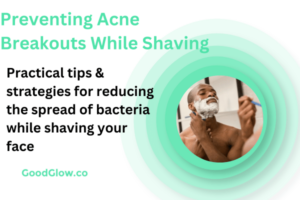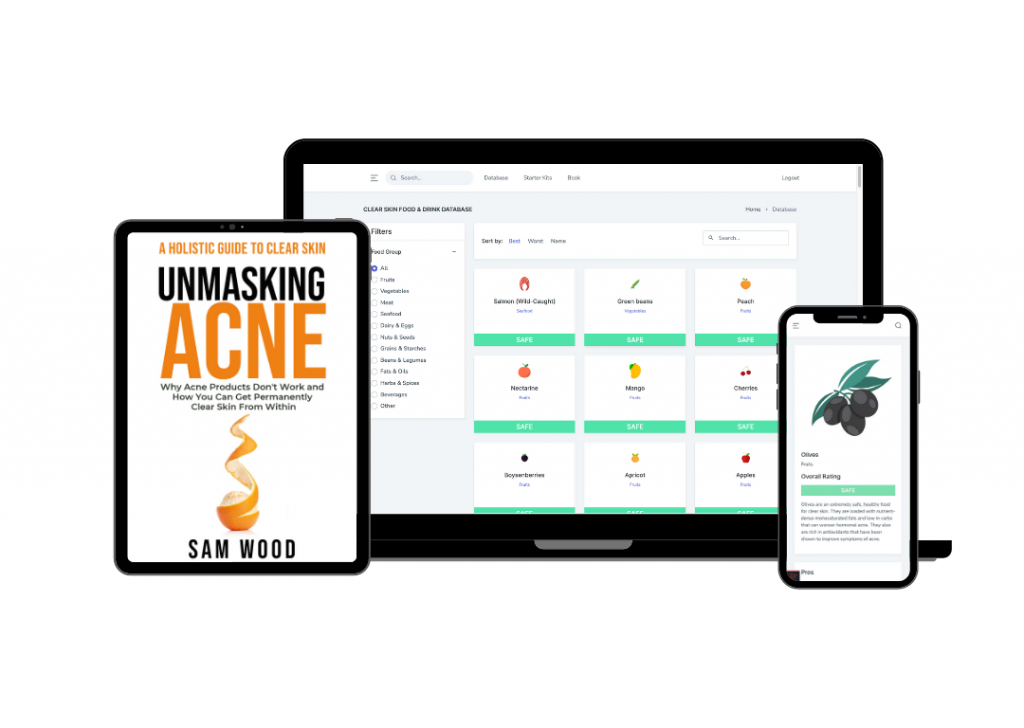Shaving does not cause acne, however shaving with existing acne breakouts and shaving with a dirty razor can spread acne causing bacteria and exacerbate existing acne breakouts on sensitive, acne prone skin.
In this article we’ll review several tips and product recommendations men with acne prone skin can follow to minimize the chances of spreading acne or rupturing existing pimples by shaving including razor maintenance, hair care tips, razor alternatives, and proper shaving after care.
Lastly, we’ll discuss how shaving can actually help keep the skin clear by removing dead skin cells and oil.
With all of this in mind, to prevent post-shave breakouts, it’s important not only to practice safe and hygienic shaving practices but also to pick the best shaving products for your skin type and needs.
1. Soften facial hair
Wash the face with warm water and a non-comedogenic, hydrating face wash before applying shaving cream. This will soften the hair follicles and lessen the chances of small cuts during shaving. This also reduces the need to shave over the same area multiple times, which can cause hair, shaving cream, oil or other debris to be rubbed into the pores.
2. Use a sharp, clean razor
A sharp, clean razor provides a clean shave and minimizes the chances of irritating the skin or rupturing existing pimples, whereas a dull razor will cause drag when shaving, and is much more likely to create micro tears in the skin which can become infected with bacteria and trigger acne breakouts.
Dirty razors usually contain bacteria, oil, and shaving cream from previous shaves, which can be spread into the pores if used repeatedly. In order to mitigate the chances of shaving with a dirty or dull razor you should wash off your razor every time you use it and change blades at the first signs of rust or pulling from the razor.
If you are interested in finding an acne safe razor, our team put together a review of several acne safe razors.
If you decide to pick out a razor on your own we have a few tips below that should help with your selection process:
- Choose a razor with a skin guard to reduce friction and prevent irritation, especially important for sensitive or inflamed skin.
- Select a multi-blade razor with closely spaced blades to minimize skin tugging and irritation.
- Consider a single-blade razor for a simpler, gentler approach, particularly beneficial for acne-prone, sensitive skin.
3. Use a non-comedogenic shaving cream
Using non-comedogenic shaving cream is essential when shaving acne prone skin, because it minimizes the chances of clogging the pores. Blocked pores are a primary cause of acne, as they trap oil, dirt, and bacteria, leading to breakouts. Non-comedogenic products are less likely to contain ingredients that can cause pore blockages or skin irritation, which mitigate the likelihood of acne formation. Make sure to check the ingredients of your shaving cream to make sure it is safe for acne prone skin. In particular, make sure it does not contain the following ingredients:
- Alcohol: Can dry out and irritate sensitive skin, leading to an overproduction of oil.
- Fragrances/Perfumes: Artificial scents are a common cause of allergic reactions and skin irritation.
- Sodium Lauryl Sulfate (SLS): A surfactant that can strip the skin of its natural oils, leading to dryness and irritation.
- Menthol: Provides a cooling sensation but can be irritating to some skin types, particularly those that are prone to acne.
- Parabens: Used as preservatives, parabens can cause skin irritation and discomfort for some individuals.
4. Shave with the grain
Shaving with the grain (the direction your hair grows) helps to reduce irritation, cuts, and nicks, which are not only painful but can also exacerbate acne and lead to further skin inflammation or infection. Shaving against the grain might provide a closer shave, but it significantly increases the risk of razor bumps and ingrown hairs, which are common precursors of acne outbreaks. For those with sensitive or acne-prone skin, minimizing irritation during shaving could be the difference between clear skin versus a strip of razor bumps across your face.
5. Shave around acne
If you need to shave but already have existing pimples you should try to shave around the acne as much as you can. Although this will not provide the cleanest shave of all time, shaving around acne significantly reduces the chances of rupturing a pimple, which can spread bacteria and trigger further acne breakouts. Additionally, rupturing a zit or pimple significantly increases the chances of acne scarring.
6. Use an electric razor
If you need to shave over existing acne breakouts, electric razors are much less likely to break the skin than a traditional razor blade. Although you will not get as close of a shave with an electric razor it drastically minimizes the chances of irritating existing acne breakouts.
7. Use gentle aftercare
After shaving, rinse your face with cool water to help reduce inflammation and tighten pores that may have expanded due to washing your face witch warm water. Once you have rinsed your face witch cool water, pat your face dry with a clean towel and apply a gentle, non-comedogenic moisturizer or an aftershave product designed for sensitive skin.
8. Shave Less Frequently
If shaving frequently irritates your skin, and you are using a sharp, clean razor, and non-comedogenic shaving cream you may want to consider only shaving a few times per week. If the rest of your skincare routine is acne friendly this should give your skin the chance to heal in between shaves, and reduces the chances of irriration
9. Consult a Dermatologist
If your acne is severe or you’re worried about shaving with acne, it’s a good idea to consult a dermatologist. They can provide personalized advice and may be able to recommend or prescribe products that will help you shave without harming your skin.
Razor Bumps vs. Acne
Razor bumps are inflammation caused
Razor bumps, also known as pseudofolliculitis barbae, are typically triggered after shaving when hairs curl back into the skin and cause inflammation, resembling small, red bumps, whereas Acne is caused by the blockage and inflammation of hair follicles due to excess oil, dead skin cells, and bacteria, leading to varied formations like whiteheads, blackheads, and pimples. Below we have a more detailed explanation of razor bumps and acne:
Razor Bumps
Razor bumps (also known as pseudofolliculitis barbae) are caused by improper shaving techniques. This can include shaving against the grain of the hair (AKA in the opposite direction of hair growth), not properly prepping the skin prior to shaving, or shaving with a dull blade. They occur when the hair grows into the skin, rather than out. This ingrown hair irritates the follicle, which results in swelling and redness. Typically, razor bumps will clear up within a day or two.
There are a few key things you can do to prevent razor bumps. Before shaving, properly exfoliate your skin to clear the follicle. As you shave, use a shaving cream to prevent irritation. Be sure to also avoid shaving too close to the skin or pulling the skin while shaving.
Additionally, you want to make sure you aren’t shaving too frequently, as this can also lead to razor bumps. Beyond that, it’s also important to replace your razor blade frequently – we’ll talk more about that below.
Acne
Acne, on the other hand, is typically caused when excess sebum, dead skin cells, and bacteria clog the pores. Hormones also play a role in acne. If the bumps around the area where you shave look the same as the pimples you get on other parts of your face, there’s a good chance that these bumps are acne.
While the best course of action for treating acne will depend on the type of acne you’re dealing with, anyone with acne-prone skin will benefit from establishing a targeting breakout-fighting skincare routine. You’ll also want to avoid products containing ingredients that can clog the pores or irritate the skin. We’ll talk about some ingredients to steer clear of in your shaving products below.
How often should you clean and change your razor?
Knowing when to change razor blades and how to effectively clean them reduces the chances of an acne breakout by over 80%.
To avoid acne caused by shaving, be sure to replace your blades after every five to seven shaves. Doing so will also help prevent razor bumps, which can be caused by using an old, dull blade. If you have a hard time keeping track of how long you’ve been using a razor, I recommend trying a subscription service so that you’re regularly reminded to refresh your blades.
To properly and thoroughly clean your razor during your shave, you’ll want to rinse it between each swipe. This will prevent buildup of dead skin cells and other debris. After shaving, run your razor under hot water to remove the grime and sterilize it with hydrogen peroxide. Place it somewhere where it can fully dry in order to prevent any bacteria growth.
Additional Products to Use in Your Anti-Acne Shaving Routine
A proper skincare routine is an absolute must for both preventing acne and getting the best possible shave. Here are the types of products to consider adding to your routine to get the best results possible.
Exfoliating Cleanser
Exfoliating cleansers will remove dead skin cells and debris on the surface of the skin that can clog both your pores and the razor blades. Ultimately, this leads to a better shave and a clearer complexion.
While some may recommend using physical scrubs before shaving, these typically aren’t suitable for acneic skin – particularly if you’re currently dealing with breakouts. Scrubs can irritate the blemishes, and may even damage the skin to the point of causing acne scars or marks.
Instead, opt for a cleanser that contains chemical exfoliants. Salicylic acid is particularly ideal for acne-prone skin, as it is able to dive deep into the pores to dislodge debris and treat and prevent acne. Alpha hydroxy acids – such as glycolic acid and lactic acid – are also great ingredients.
Aftershave
Aftershaves aren’t completely essential, but many do prefer to use them. Good formulas can help speed up the healing process of nicks, soothe the skin, and tighten the pores.
Aftershaves can be beneficial for taking care of acneic skin post-shave, but you have to carefully select the right product. Just like with shaving creams, some can contain ingredients that trigger acne and irritate the skin.
For those with breakout-prone skin, I suggest ones that contain antiseptic ingredients like witch hazel or tea tree oil. Both of these ingredients fight acne and have soothing properties, and also work to disinfect any nicks. Gentle moisturizing ingredients – such as aloe and glycerin – are also great additions.
Some aftershaves – particularly those made specifically for acne-prone or oily skin – are formulated with salicylic acid. These are suitable options for both preventing breakouts and ingrown hairs.
A lot of aftershaves contain alcohol, but I recommend avoiding these. Alcohol-based aftershaves can dry out and/or irritate the skin, which will ultimately do more harm than good. For the same reason, skip dyes, added fragrances, or menthol.
Shaving with Current Breakouts
On a final note, it’s also important to highlight that you should skip the shave if you’re currently dealing with a painful, inflamed breakout. Doing so will just irritate the skin further, and will likely lead to acne scars and post-inflammatory hyperpigmentation.
If you have some mild or moderate acne, you can still shave using the tools and techniques mentioned above – you just need to do so with a bit of extra caution. Try to shave around any blemishes as much as possible, and use a light touch when navigating the area.

